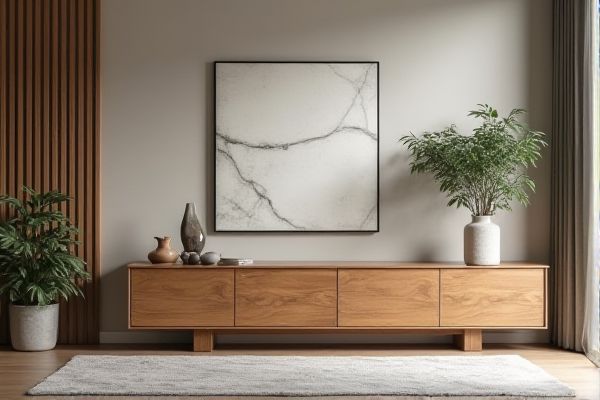
A sideboard typically features cabinets and drawers ideal for dining rooms, while a credenza often offers open shelving and a sleek design suited for offices or living spaces. Explore the key differences and discover which furniture piece best suits your needs in the rest of this article.
Table of Comparison
| Feature | Sideboard | Credenza |
|---|---|---|
| Definition | A low storage cabinet typically used in dining rooms for dishes and linens. | A long, low storage unit often used in offices or living rooms for storing electronics and documents. |
| Primary Use | Dining room storage and serving surface. | Office storage or media console. |
| Design | Often features drawers and cabinets with a decorative style. | Sleek, minimalist design with sliding or hinged doors. |
| Materials | Typically wood, sometimes mixed materials. | Wood, metal, or laminate finishes common. |
| Height | Generally around 30-36 inches tall. | Typically lower, around 28-32 inches tall. |
| Storage Features | Drawers and cabinets for dishes, silverware, linens. | Open shelves, cabinets for files, electronics, or media devices. |
| Placement | Dining room, adjacent to table. | Office, living room, or entryway. |
Understanding Sideboards and Credenzas
Sideboards and credenzas are both versatile storage pieces commonly used in dining rooms and living areas, but they differ in design and functionality. Sideboards typically feature a combination of drawers and cabinets ideal for storing dining essentials, while credenzas tend to have a sleeker, low-profile design often used for media storage or office organization. Understanding these distinctions helps you choose the right furniture to complement your space and meet your storage needs effectively.
Key Differences Between Sideboards and Credenzas
Sideboards typically feature taller designs with enclosed storage and are ideal for dining rooms, while credenzas are lower, often with sliding doors or open shelves, suited for office or living room use. Sideboards emphasize vertical storage for dishes and linens, whereas credenzas prioritize horizontal space for media equipment and documents. Understanding these distinctions helps you select the right piece to optimize both style and functionality in your space.
Historical Origins of Sideboards and Credenzas
Sideboards originated in 18th-century Europe as multifunctional dining room furniture designed to store serving dishes and display fine china. Credenzas trace back to Renaissance Italy, where they were used in noble households to confirm the safety and quality of food and wine, evolving into elegant storage cabinets. Your choice between a sideboard and a credenza can reflect both historical style preferences and functional needs in modern interiors.
Design Features of Sideboards
Sideboards typically feature a combination of drawers and cabinets designed for versatile storage, often with raised legs to give a lighter, more elegant appearance. These design elements make sideboards ideal for dining rooms to store tableware and linens while providing a surface for serving. Your choice of a sideboard can enhance both functionality and style by complementing traditional or contemporary interior decor.
Design Features of Credenzas
Credenzas are designed with sleek, elongated shapes and low profiles, often featuring sliding doors and open shelving that maximize storage while maintaining a clean, minimalist look. Unlike sideboards, credenzas prioritize horizontal lines and smooth surfaces, making them ideal for modern and contemporary interiors. Your space benefits from their versatile design, providing both functionality and stylish appeal in living rooms or dining areas.
Common Uses in Modern Homes
Sideboards are commonly used in dining rooms for storing dishes, flatware, and linens, while credenzas often function as storage and display units in living rooms or home offices. You can maximize space by using a sideboard to keep serving essentials organized and easily accessible during meals. Credenzas offer versatile surface area for electronics, decorative pieces, or workspace materials, blending functionality with aesthetic appeal in modern homes.
Choosing the Right Piece for Your Space
When deciding between a sideboard and a credenza, consider your storage needs and room layout to maximize functionality and style. Sideboards typically offer taller storage with cabinets and drawers ideal for dining rooms, while credenzas are lower-profile, providing ample surface area perfect for living rooms or offices. Your choice should balance aesthetics with practical use, ensuring the piece complements your space while meeting storage demands.
Material and Style Options
Sideboards and credenzas offer diverse material and style options to suit various interior designs; sideboards often feature wood, metal, or glass, blending traditional and contemporary styles, while credenzas typically emphasize wood with sleek, mid-century modern or minimalist aesthetics. You can find sideboards with intricate carvings or metal accents that add a decorative element, whereas credenzas focus on clean lines and functional forms. Selecting the right material and style depends on your room's ambiance and storage needs, balancing durability with visual appeal.
Maintenance and Care Tips
Sideboards and credenzas require regular dusting with a soft cloth to prevent surface scratches and maintain their finish. Avoid placing them in direct sunlight or near heat sources to prevent warping or fading of wood and veneers. Periodic use of a suitable wood polish or conditioner helps preserve the material's integrity and enhances the furniture's longevity.
Sideboard vs Credenza: Which Should You Choose?
Sideboards typically feature a combination of drawers and cabinet doors ideal for dining room storage, while credenzas often have sliding doors and a lower profile suited for living rooms or offices. Your choice depends on the intended use and room layout; sideboards provide versatile storage for dishes and linens, whereas credenzas are designed for media equipment and files. Selecting between a sideboard and a credenza ensures you optimize space and functionality tailored to your needs.
 homyna.com
homyna.com